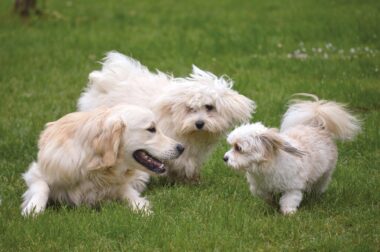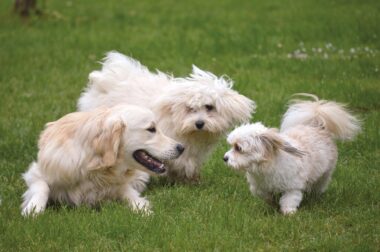Socializing Your Dog: Dos and Don’ts
Socializing your new dog is crucial for their development and your overall relationship. Start early, ideally within the first few weeks of bringing them home. Gradual introductions to new environments, people, and other dogs will help your dog become well-adjusted and confident. One effective approach is to take them on frequent walks in various places. Different sights, sounds, and smells are all part of the experience. It’s essential to remain calm and composed during these outings. Dogs can sense their owner’s emotions, and your anxiety may transfer to them. Thus, take baby steps, allowing your dog to acclimate while rewarding positive behavior. Additionally, consider enrolling them in a basic obedience class. This not only aids in training but also facilitates interactions with other dogs in a controlled environment. Inevitably, not all dogs will respond to socialization efforts straightforwardly, which is a natural part of their temperament. Patience is key. Monitor their body language, as signs of discomfort or aggression towards other animals must not be ignored. Your dedication will result in a more sociable and happy canine companion.
Once your dog is introduced to various new experiences, it’s vital to establish a safe and comfortable routine. Regularity aids in building confidence in your dog. Include designated playtimes, designated potty breaks, and consistent feeding schedules. These routines become reassuring for your furry friend. Furthermore, provide a safe space where they can retreat when feeling overwhelmed. This safe environment might be a cozy bed or a favorite corner in your home, which helps your dog decompress in stressful situations. Avoid overwhelming them with too many new experiences at once. Gradually expose your dog to one new element at a time, ensuring each encounter is positive. Be vigilant about observing your dog’s reaction; if they show signs of stress, withdraw from the situation and try again later. Sometimes, inviting friends with friendly dogs over for socialization can create a pleasant interplay while teaching your dog proper social cues. Remember to reinforce good behavior with treats and praise, solidifying their understanding of acceptable interactions. Effective socialization paves the way for a well-rounded dog, ensuring you both enjoy companionship without anxiety or fear.
Understanding Your Dog’s Body Language
Learning to read your dog’s body language is essential in socializing them effectively. Dogs communicate through a range of signals such as ear positioning, tail posture, and facial expressions. For instance, a wagging tail often indicates excitement and openness. However, high or stiff tail wagging might indicate agitation or assertiveness. Pay close attention to these nuances. A relaxed dog will have a properly positioned tail, soft eyes, and a relaxed mouth. Conversely, if your dog’s ears are pinned back, and their eyes appear wide, they may feel threatened. Establishing a comfort level in various situations helps your dog understand where it is safe to act naturally. Don’t rush the interactions; allow your dog to engage at their pace. If they seem uncomfortable, it’s okay to create space and let them acclimate. Familiarize them with friendly, calm dogs as role models for social behavior. Senior dogs, in particular, can assist in modeling appropriate social conduct. Ultimately, fostering a positive environment for your dog helps reduce future anxiety during social situations and enhances your bond as team partners.
While socializing your dog, don’t forget to consider their individual personality and background. Dogs come with diverse temperaments influenced by their breed, life experiences, and training history. Some breeds are naturally more outgoing, while others may possess a more reserved nature. It’s crucial to tailor your socialization experiences accordingly. If your dog experiences anxiety or aggression issues, gradual exposure without forcing interaction is essential. Avoid setting them up for failure by introducing them to overly boisterous dogs or chaotic situations too soon. Remember also to balance exposure to both humans and dogs. File a list of ideal socialization environments, such as local parks, canine cafes, and training classes. Each experience will build on the last, fostering comfort in a variety of contexts. Also, stay consistent; regular outings can remarkably reduce anxiety. Additionally, partner with a professional dog trainer if you encounter any significant challenges — their expertise can provide tailored strategies to ease the process. The socialization experience should be viewed as a journey, where taking small meaningful steps can lead to significant improvements over time.
Dos and Don’ts of Dog Socialization
There are specific dos and don’ts while socializing your dog to ensure progress. First, do include positive reinforcement in your training method. This means rewarding your dog with treats or praise whenever they exhibit desired behavior during social interactions. Keep socialization sessions short and always prioritize quality over quantity. Focus on building positive experiences, as these create an emotional imprint on your dog’s memory. Do remain calm and use a gentle voice to format a reassuring atmosphere. Alongside dos, there are also important don’ts to take to heart. Don’t expose your dog to large crowds if they seem unsettled. This could lead to increased anxiety and potential negative reactions. It’s essential not to force them to encounter another person or dog if they are clearly uncomfortable. This behavior could teach your dog that socialization is a frightening experience. Lastly, don’t forget your vet’s advice on vaccinations; dogs should complete their initial vaccinations before engaging with unknown dogs in public. Following these guidelines ensures that your socialization efforts are productive and rewarding.
As you embark on your dog’s socialization journey, planning various outings is key to exposing them to diverse situations. Look for local businesses that are dog-friendly, such as pet stores or cafés, to ensure positive experiences. Always assess whether the atmosphere is relaxed and comfortable for your dog. You can also arrange playdates with trusted friends who have calm dogs to gradually introduce your pet to social sparks. Invite these friends over to your home initially, as this will allow your dog to feel secure in a familiar environment first. Once comfortable, transitioning to outdoor environments will be more manageable. Gradually increase exposure to different stimuli like loud noises, moving vehicles, and public transport. Ensure to replicate different environments gradually; this may include parks, busy streets, and beaches, where your dog can learn to adapt to unfamiliar surroundings. Don’t overlook the value of having regular excursions; balance chaos with quiet time, allowing your dog to unwind and process experiences at home. Creating a broad schedule will buffer the impact of each social instance, facilitating their gradual transformation into a confident, well-socialized companion.
Conclusion: The Importance of Patience
In conclusion, socializing your new dog is a rewarding experience that necessitates patience and a well-thought-out approach. Establish a steady routine and prioritize calming, positive experiences for your pet. Remember that every dog is unique; some may need more time than others to acclimate to new surroundings. Regular observation of their body language is essential to gauge comfort during interactions. It’s perfectly normal for your dog to show bouts of anxiety, but with consistency and understanding, improvement is achievable. Set realistic goals and celebrate small accomplishments throughout the socialization process. Every little victory counts in building your dog’s confidence and social skills. If challenges arise, think about seeking out a dog trainer or joining a local training class; having guidance could make all the difference. Always rely on positive reinforcement while interacting with your dog in new scenarios. Ultimately, fostering a well-socialized dog leads to a fulfilling relationship for you both. A well-rounded dog becomes a happy family member, contributing positively to your household. So take the time, enjoy the journey, and cherish the bond you grow along the way.






